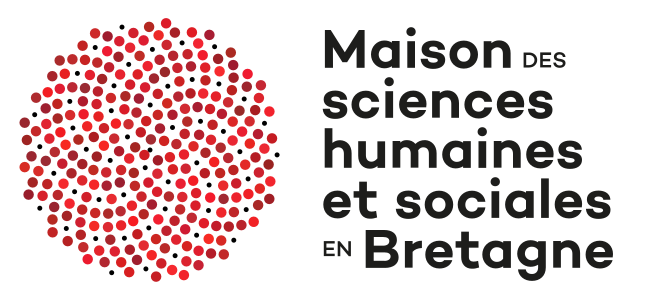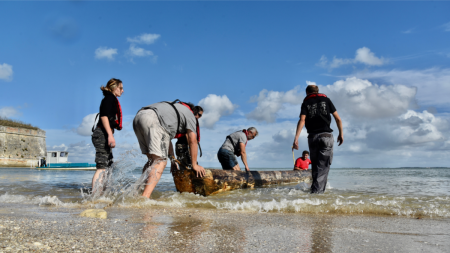Résumé
Que ce soit en mer ou dans les eaux intérieures, l’usage des moyens de transport nautiques par les populations préhistoriques ne se laisse pas aisément approcher et on doit composer avec la grande rareté des témoins archéologiques. Il est cependant possible de préciser certains aspects chronologiques et fonctionnels en analysant les rares épaves, équipements et représentations qui nous sont parvenus. Une autre approche complémentaire consiste à reconstituer des embarcations – ici du Néolithique car les vestiges archéologiques y sont plus nombreux et il a été le théâtre d’importantes migrations au-delà des mers – à partir de répliques d’outils en pierre et de les tester sur les eaux. Le projet NEONAV est original par les partenaires qu’il regroupe, à la fois issus du monde académique (CNRS, Inrap, Universités, réseau des MSH) et du monde associatif (Koruc, RSPB, AMARAI), à la fois professionnels et bénévoles de l’archéologie. Car tout en respectant une démarche scientifique afin de reconstituer les chaînes opératoires ou les principes de navigation anciens, NEONAV souhaite également devenir un formidable outil de médiation auprès d’un public varié à partir d’un objet emblématique de la Préhistoire qu’est la pirogue monoxyle. Il s’agit donc clairement d’un projet de science participative impliqué dans d’autres recherches plus larges (ANR, ERC) dépassant les limites de la Bretagne.
Whether at sea or inland, the use of nautical means of transport by prehistoric populations is not easy to approach and we have to deal with the great scarcity of archaeological evidence. However, it is possible to clarify certain chronological and functional aspects by analysing the rare wrecks, equipment and representations that have come down to us. Another complementary approach consists of reconstructing boats - in this case from the Neolithic period, as there are more archaeological remains and it was the scene of major migrations across the seas - from replicas of stone tools and testing them on the water. The NEONAV project is original because of the partners it brings together, both from the academic world (CNRS, Inrap, Universities, MSH network) and the associative world (Koruc, RSPB, AMARAI), both professionals and volunteers in archaeology. While respecting a scientific approach in order to reconstitute the chaînes opératoires or the principles of ancient navigation, NEONAV also wishes to become a formidable mediation tool for a varied public based on an emblematic object of Prehistory, the dugout canoe. It is therefore clearly a participatory science project involved in other broader research projects (ANR, ERC) that go beyond the limits of Brittany.
Michel PHILIPPE Archéologie UMR 7324 CITERES-LAT | Bertrand POISSONNIER Archéologie UMR 5608 TRACES | Panagiota MARKOULAKI Archéologie Autre / étranger |
Philippe GUILLONNET Expérimentation archéologique Eveha (Société d'archéologie préventive) | Emmanuel GUERTON Expérimentation archéologique ArtPaléo | Yolaine MAIGROT Archéologie, Tracéologie UMR 8215 Trajectoires |
Camille GONTIER sociologie EA 4451 CRBC |
Criteria : Id : "halshs-03898352;halshs-03984122;hal-04177512;hal-04660967"
Number of occurrences founded : 4.
- titre
- Pirogues et travail du bois au Néolithique : caractérisation des traces et des déchets produits expérimentalement. Vers la constitution d'un référentiel
- auteur
- Bertrand Poissonnier, Vincent Bernard, Philippe Guillonnet, Paul Bacoup
- article
- Archéopages : archéologie & société, 2023, 49, pp.102-111. ⟨10.4000/archeopages.16448⟩
- titre
- The tree that obscures the forest
- auteur
- Michel Philippe
- article
- Hiatus, lacunes et absences : identifier et interpréter les vides archéologiques, Actes du 29e Congrès préhistorique de France, 31 mai-4 juin 2021, Toulouse, 2023
- titre
- Looking for the perfect tree? Selecting and felling a Neolithic logboat tree
- auteur
- Paul Bacoup, Bernard V., Emmanuel Guerton, Philippe Guillonnet, Jacky Meslin, Michel Philippe, Bertrand Poissonnier
- article
- 6th International congress of experimental archaeology, Oct 2022, Pezenas, France
- titre
- Archaeological record of transport on inland waters in independent Gaul: where are the boats?
- auteur
- Michel Philippe
- article
- Bertrand Bonaventure; Stéphane Carrara. Axes fluviaux et territoires à l’âge du Fer. Actes du 44e colloque international de l’Association française pour l’étude de l’âge du Fer (Lyon, 21-23 mai 2020), AFEAF, pp.9-22, 2022, Collection Afeaf (4), 978-2-9567407-3-5

